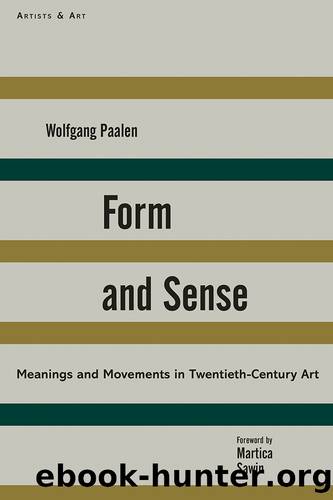Form and Sense by Wolfgang Paalen

Author:Wolfgang Paalen
Language: eng
Format: epub
Publisher: Arcade
Published: 2013-01-01T00:00:00+00:00
Gordon Onslow-Ford. Propaganda for Love. 1940. From the collection of the Lucid Art Foundation, used by permission.
Yet the Marxist error is comprehensible, for it was chiefly derived from a consideration of the âofficialâ art of the 19th century. A business age founded largely on the idea of individual profit could of course not achieve a spontaneous collective expression, a style. In fact, in a civilization chiefly concerned with the exploitation of one another, every expression in any way related to this motive is necessarily proscribed. Such a civilization must feel repugnance, and with good cause, before any sincere visualization of its real desiresâand allows the artists in its pay nothing but âidealisticâ mummery. Thus a bourgeois civilization, allowing only hypocritical expression, could produce nothing but pseudo-art, a dull and ridiculous potpourri of earlier cultures and styles. âOfficial art,â so astonishingly uniform in all âcivilizedâ countries of the world from the beginning of the last century to our days, proves it. It was no more than natural that those art products became associated with other stupid articles of the luxury trade and that such an art became a question of âtaste.â (Critics came to take their vocabulary from the kitchen.) In the midst of this civilization, that art which is the true expression of profoundest human needs and desires could only survive at a terrible price: at the price of quitting its place in daily life. Such was the significance of the sad formula âart for artâs sake.â
The conflict appears for the first time without equivocation in Baudelaire and Courbet. Naturalism could hardly be understood otherwise than as the first âcrise de conscienceâ of modern art. If Flaubert and Cézanne afterward came to confound nature with realism, they only shared the materialist error of their time. A time which denounced the poets as another time denounced those who practiced witchcraft. Any innovating artist was condemned to misery. And yet Rimbaud, Lautréamont, van Gogh and some others tried desperately to rebuild the bridge between art and life. Since that time art has been reaffirmed more and more strongly in its authentic role as one of mankindâs most vital expressions. When the molds of a sterile aesthetic were shattered, art became fatally concerned with the crucial problem of our time: social conflict. Yet it must be plain that raising the ethical question in art, important as it may be, is no aid in discussing the value of certain pictorial expressions, for the simple reason that there is no less general confusion at present about ethical values than there is about aesthetic values. Thus it is necessary for the purpose of objective analysis to turn to the sole (if most restricted) language which today still can pretend to universality: the language of science. But to be aware of the necessity of scientific method in analysis does not mean that such analysis can ever take the place of immediate experience in matters of art.
2. The most complex art movement of the last fifteen years became
Download
This site does not store any files on its server. We only index and link to content provided by other sites. Please contact the content providers to delete copyright contents if any and email us, we'll remove relevant links or contents immediately.
| Ancient & Classical | Arthurian Romance |
| Beat Generation | Feminist |
| Gothic & Romantic | LGBT |
| Medieval | Modern |
| Modernism | Postmodernism |
| Renaissance | Shakespeare |
| Surrealism | Victorian |
4 3 2 1: A Novel by Paul Auster(11076)
The handmaid's tale by Margaret Atwood(6875)
Giovanni's Room by James Baldwin(5896)
Big Magic: Creative Living Beyond Fear by Elizabeth Gilbert(4736)
Asking the Right Questions: A Guide to Critical Thinking by M. Neil Browne & Stuart M. Keeley(4600)
On Writing A Memoir of the Craft by Stephen King(4222)
Ego Is the Enemy by Ryan Holiday(4004)
Ken Follett - World without end by Ken Follett(3984)
The Body: A Guide for Occupants by Bill Bryson(3817)
Bluets by Maggie Nelson(3724)
Adulting by Kelly Williams Brown(3681)
Guilty Pleasures by Laurell K Hamilton(3601)
Eat That Frog! by Brian Tracy(3528)
White Noise - A Novel by Don DeLillo(3443)
The Poetry of Pablo Neruda by Pablo Neruda(3372)
Alive: The Story of the Andes Survivors by Piers Paul Read(3321)
The Bookshop by Penelope Fitzgerald(3237)
The Book of Joy by Dalai Lama(3237)
Fingerprints of the Gods by Graham Hancock(3223)
